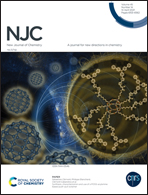Probing supported bimetallic Pt–In sites in glycerol hydrogenolysis†
Abstract
This work studied platinum and indium supported on alumina and silica as monometallic and bimetallic catalysts for the aqueous phase hydrogenolysis of glycerol towards 1,2-propanediol (1,2-PDO). The prepared catalysts were characterized by N2 physisorption, XRD, TPR, pyridine adsorption DRIFTS, TPD-H2, TPD-CO, H2 and CO chemisorption, and TEM. For alumina-supported catalysts, there was a conversion of 39% when using Pt/Al2O3 and 33% when using Pt–In/Al2O3. The In/Al2O3 catalyst did not perform well, showing a conversion of 2%. Turnover frequencies for Pt/Al2O3 and Pt–In/Al2O3 showed values of 1.8 × 10−1 s−1 and 3.0 × 10−1 s−1, respectively, considering H2 chemisorption for active site measurements. From the characterization of the catalysts, it can be inferred that In dilutes Pt in bimetallic particles, creating more selective Pt–In sites for the APH of glycerol. The influence of the catalyst structure, bimetallic Pt–In particles and different supports is discussed.



 Please wait while we load your content...
Please wait while we load your content...